
My/the dream team for architecture:
Sony A7R with Canon 17mm/4 TS-E
By Dierk Topp
First I would like to mention, that I am not a Pro, I take pictures for my own pleasure and sometimes for others.
I bought the Canon 17mm TS-E for use with the ordered Leica M240, but when I got the M240, I sent it back after 2 days. The main reason (besides many others) was, that the focus field in life view was fixed in the center. Using tilt lenses with a focus only in the center of the frame is useless, and for shooting a portrait session, when you want the focus on the eyes is useless with a focus control in the center of the image, and shooting stills from a tripod with a fixed focus field in the center is useless as well.
I ended having no FF body for this lens! So I tried to use the 17mm TS-E with my Leica M9 and the MM and it was no problem. I used the 18mm finder for a rough composition and very often had to do only one or two test shots (no live view!) till I got, what I wanted (you will find two images from the M9 at the bottom).
When then the A7R arrived in October 2013, I discovered a big problem: my Metabones adapter Ver.1 was unusable, it is blocking the edges and the vignetting made it unusable. But I found the info, that the new Metabones Mk. III supports FF and I was very happy, when I got it a few days later and it worked perfect.
Why using a tilt/shift lens?
If you know about tilt/shift lenses, there is not too much to say about shooting this combination.
If not, here is an excellent post on shooting architecture with shift lenses:
Let me quote a few sentences, I hope you don’t mind James?
- Point your camera up at a tall building. See how the lines of the building converge to the top of the frame? That’s an extreme case of perspective distortion. For a shot like that, sometimes it looks cool. But back up a good bit, zoom out, and try to shoot the entire building. More times than not, you’ll notice the verticals are not perfectly straight. It’s extremely difficult to get it right handholding the camera and trying to guess. That’s because in order to have no perspective distortion, you have to have the capture plane, be it film or digital sensor, parallel and plum with the building.
- There is a lot of misunderstanding about tilt/shift lenses. Basically, it’s a lens that projects an image circle much larger than the frame it intends to cover. Then, it is allowed to be moved independently of the camera body to anywhere within the projected image circle.
If you are interested in the tilt function of this lens, you find an excellent description here at the site from Keith Cooper:
http://www.northlight-images.co.uk/article_pages/using_tilt.html
Now let the images speak for themselves.
- images made with f/8 and tripod
- as the camera is on a tripod, I very often just shoot additional shifted images and have more freedom during PP for stitching
- very often prefer a different aspect ratio than what I get out of the camera and stitch images by shooting two or three frames with different shifted lens. And very often I shift the lens more than recommended and decide later, if I have to cut the outer (blurred) part of the image. With stitched images there is plenty of resolution for that. But you have to plan that during shooting.
- if I want to get a wider angle of view and shift up (or down), I use two images with the lens shifted left and right up by 30° or 60°
- if you have a close foreground and/or have to avoid parallax error with slightly differing images from moving the front lens by the shifting, you can use the special “Canon TSE Tripod Collar” from Hartblei: http://www.hartblei.de/en/canon-tse-collar.htm, this collar is mounted on the front part of the lens and keeps it in exactly the same position, while the rear part of the lens including the camera is being moved for shifting.
- my post processing: LR 5.3, B&W conversion with Nik Silver Efex PRO2, stitching with PTGui or MS ICE (free for Windows)
The A7R or ILCE-7R with the Cannon 17mm/4 TS-E on Metabones smart adapter III
(I took the pictures with the NEX-6 and Micro Nikkor 85mm/2.8 PC, also a tilt/shift lens, on a Metabone adapter, tilted for more DOF)
the lens on this picture is shifted up for about 9mm, as you can see on the scale on the lens in the middle of it.
The front part of the lens for tilting is not tilted, you can see it on the second picture below.
The Metabones MK III adapter supports the electronic diaphragm and correct EXIF, this lens is manual focus (as all shift lenses) and I could not test the AF support of the adapter.
and here are some images made with this fantastic combination:
One shot shift up
–
This one stitched of two shifted images (shift left and right), no HDR, 11.000×5.000 pixel
–
This is a 1:1 crop of this picture
–
Gut Trenthorst
again from two stitched images, but this time the shift was 30° up to the left and right, to get the view upwards
–
from two shifted images (no HDR, the sensor has no problem with this high contrast!)
–
Now some pure architecture shots
This is just a standard shot, lens shifted up
–
HavenCity, Hamburg
Shifted full 12mm up, recommended is 8 to 10mm on the long side, the top of the building is getting blurred!
–
If the camera is perfectly aligned, buildings tend to look strange, as if the top is getting bigger,
just a bit perspective distortion could look more natural.
–
Bad Oldeloe, Germany
stitch of two images, shifted down and up
–
Three images, shifted left, center and right
image size 12.000×5.000 pixel
–
… the same, three stitched images
–
and Hamburg, Speicherstadt
Three images shifted, 11.000×5.000 pixel
–
…and two images, shifted up 30° left and right, 9.200×5.000 pixel
–
Last but not least:
You can even use this lens on a range finder. Here are two images made with the Leica M9 with a cheap adapter. I used the 18mm finder on the M9 for rough composition and one or two shots, till I got it right. The M9 has no live view for controlling the image before the shot! And for the electronic aperture you need a trick with an extra Canon body.
The Marienkirche, Lübeck, Germany
–
This is a special combination of shifted lens up on the M9 and rotating the camera on the tripod for much more than 120° view. I shot many very much overlapping images to make sure, that it will work for stitching – and I think it worked 🙂
Thanks for your interest and I hope, you find it informative and useful … and sorry for my English 🙂
More images are on my flikr:
Canon 17mm TS-E tilt/shift (including A7R) and the Sony A7R images
thanks and kind regards
dierk

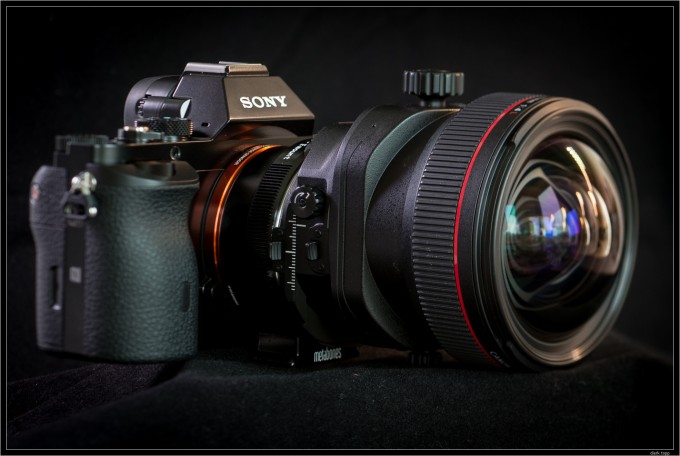
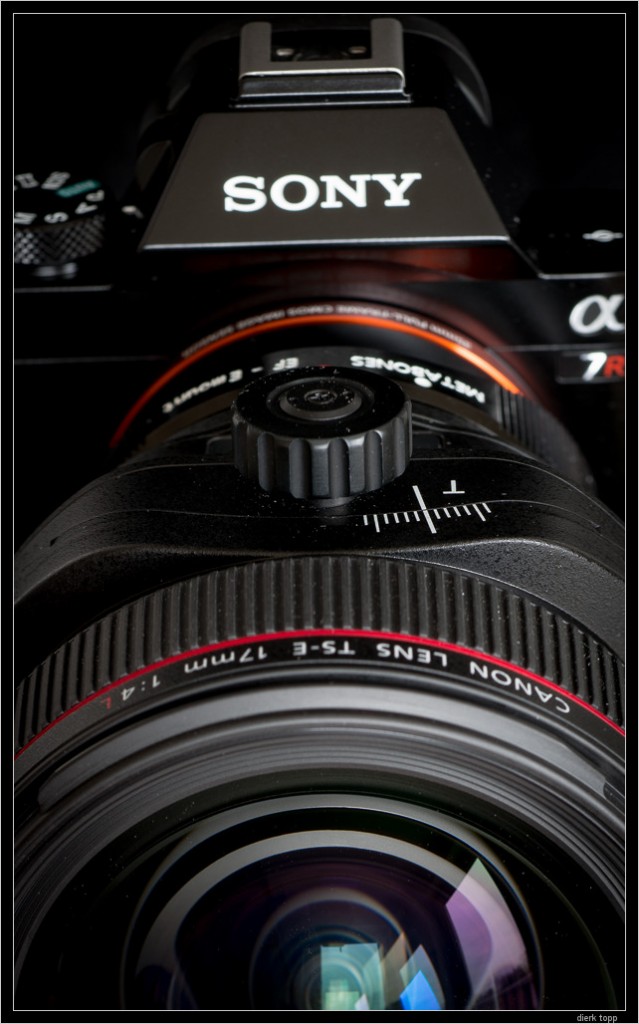


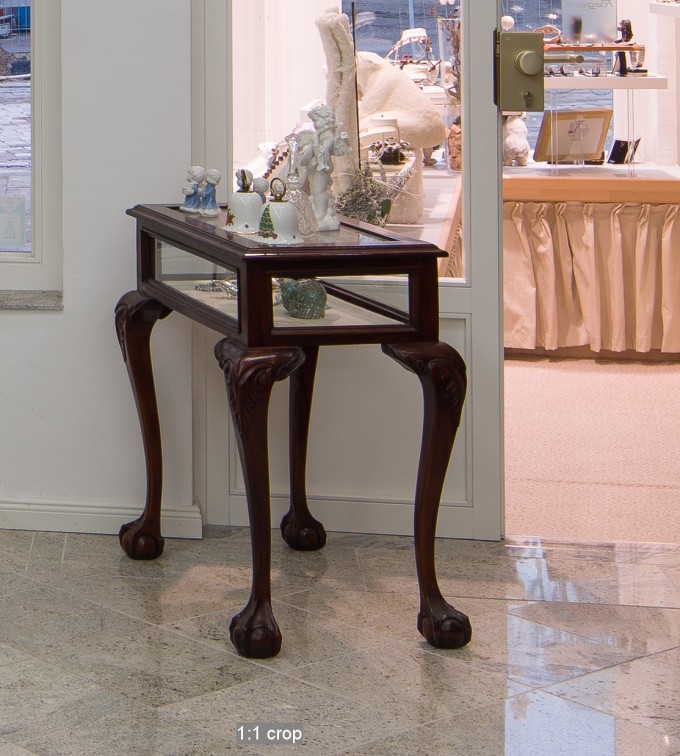
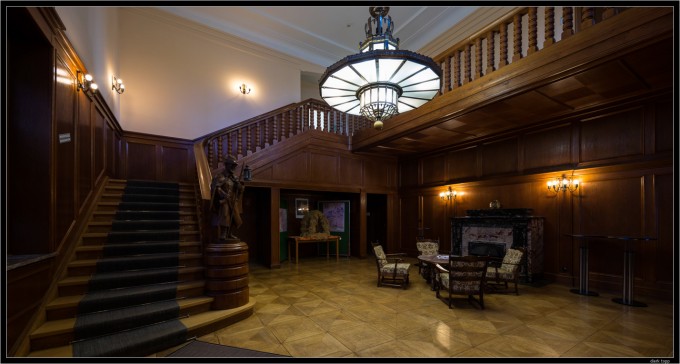
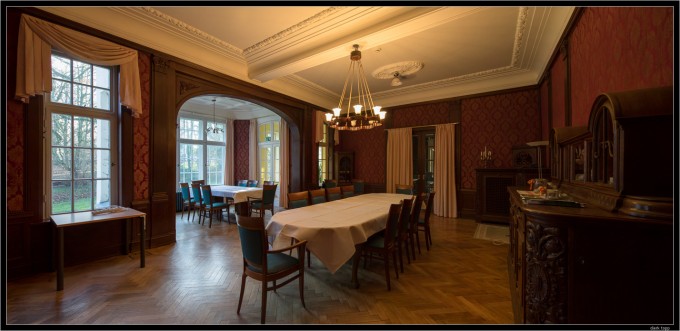
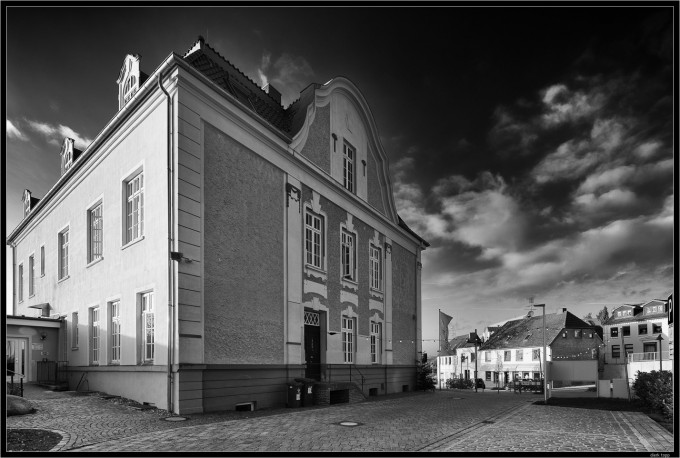
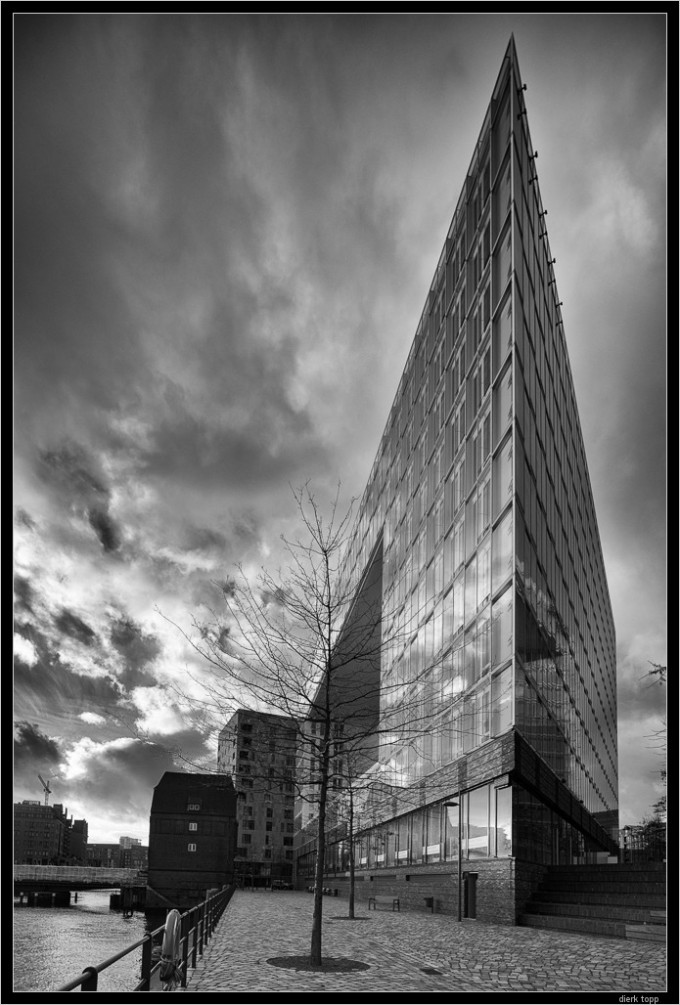

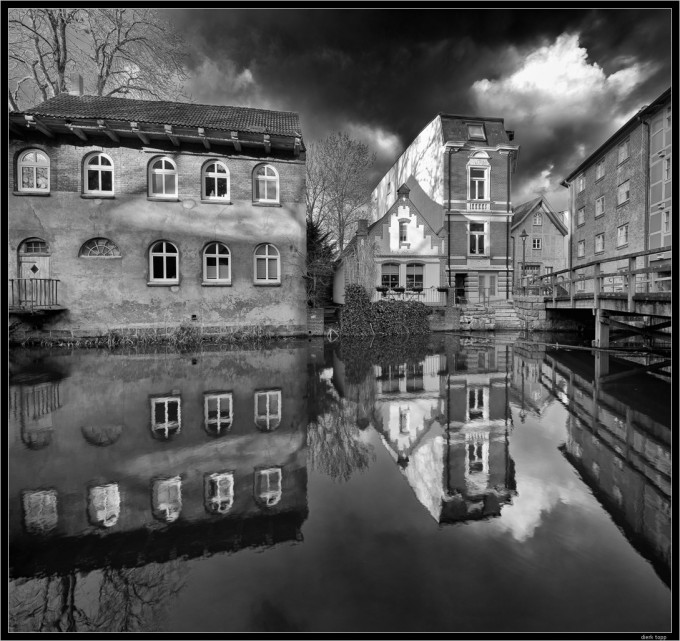


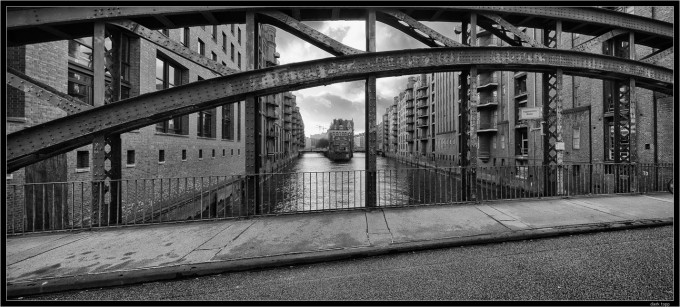
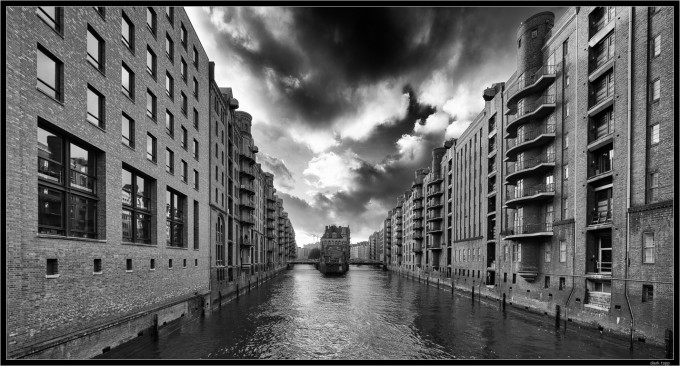

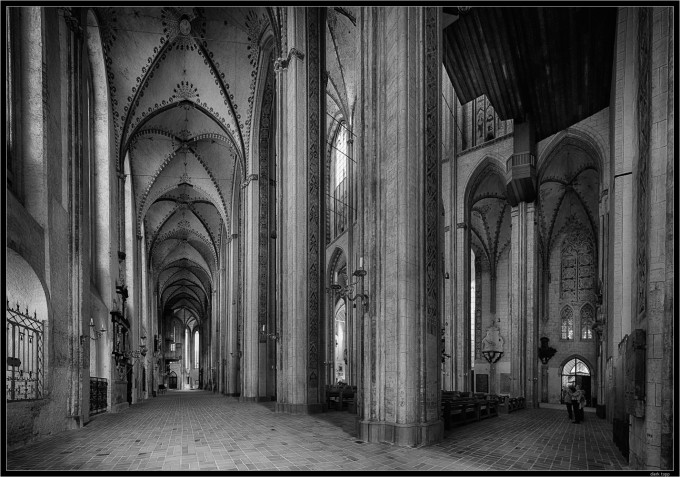



We with to thank you for sharing your innovative approach with fellow photographers. For our clients, stewardship includes presenting fine architectural renderings in Unique Homes, DuPont Registry, our and other channels. We use nikkor pc e, but we find application for our multi-story listers with across lake burton to the Blue Ridge mountains where 17 mm with good composition, exposure and off camera speed lights would make 17 mm a desirable option. And hence our reference to your innovation! As we will be new to the ts e {canon}, but not to Sony sans mirror, which we use with older Minolta primes – does metabone on A7R permit setting aperture manually? Or does metabone on your A7R facilitate auto-exposure? With nikkor pc e on Nikon d700, aperture and focus of course are each manually selected.
Kind regards and thank you,
Julie & Leigh
http://www.lakerabunhomes.com
Just as with conventional optics we chose the focal length most appropriate to the image we wish to capture. If the Canon 24mm version would be more appropriate, then use it. But the 24mm won’t capture what the 17mm can. So it is very much horses for courses. It is the extreme wide angle aspect of this lens that sets it apart from the more usual focal lengths used for tilt and shift applications on FF and which tend to be between 24mm and 35mm.
It is, of course, a very specialised optic (and I feel this is the point you miss) and it won’t suit everybody.
I do not want to complain or criticize all these nice Images, and the tool lens, but for my taste, the 17mm SWA lens, as an S&T lens, is for many puposes too much wide, 24/25mm would be much more unique and sufficient. Furthermore, the whole mechanics of this lens, is also very slow and complicated. There are other S&T lenses on the market, who are much better to handle.
Sorry, I forgot to mention. In the case where a lens is not coupled (i.e. the Canon 17), I still use the LV focus feature, but only to set my “near and far points” in my desired focus range. Then I sent the proper aperture using the depth-of-field scale on the lens as a guide. Thanks!
Hey. Sorry for the belated comment; just happened upon this post. To your comment on the M & it’s center focus issue in LV. I use my M for much architectural shooting, but for now only have the 21mm Biogon as my widest lens. I always use LV when shooting architecture (with any focal length) but instead of relying on the center focus feature, I focus on the near & far points in my field of view that I want in-focus (using the rangefinder), and I rely on the depth-of-field scale to shoot at the desired aperture. I get exactly the range of focus I desire, consistently. I’d like to investigate the 17mm Canon lens further. Thanks for a great post!
Hi Dierk
I have a quick question regarding the 17mm TSE lens. I’m a long time user of the 24mm TSE MK1 and shoot 5×4 too so I have lots of shift knowledge. I often stitch 2 images left and right to get wider shots but when shooting from ground level it’s not possible to shift up and then rack left and right at the same time.
In your write up the image of the staircase has the caption “again from two stitched images, but this time the shift was 30° up to the left and right, to get the view upwards”
Does this mean you managed to shift the lens up, and then left and right so you crop out the floor area? Thus effectively utilising the top two corners of the image circle and have corrected perspective.
Any thoughts would be great.
Thanks
James
thanks for the help and explanation, Terry.
This seems to be the question.
Hi, Dierk.
I’m thinking that the Sony sales person mistakenly referred to cropping when he may have meant vignetting, especially as this was said in the context of the super wide angle 17mm focal length.
It was clear from your images that this is not the case, so perhaps he doesn’t realise that the imaging circle of the 17mm lens is, by design, meant to cover the movements. Just a thought.
I am not sure, if i understand your question.
The A7 has a FF sensor and there should not be any cropping compared to FF sensor of DSLR.
I am thinking of upgrading from a Canon 5DII to a 5DIII, but am leaning toward the Sony A7R. I used Canon L lenses, Have you found any cropping with the 17 T/S? I have a 24 T/S and the Sony sales person mentioned cropping as a potential problem, but didn’t know how much, if any with Canon.
Stan
Thank you very much for the information. I checked out the advertisement of the new A7s. Interesting with 12 mp! I have been waiting for 6 years now to buy a full frame. I am going to do it this time.
Hi, Dierk. I missed this announcement. Seems Sony has 4k video in mind, as it will have a 12 meg sensor. I think a bridge too far for stills use, except it promises ultimate high ISO performance. A bit of a specialist camera, perhaps?
Teen,
Dierk may wish to come back on this, but the Metabones smart adaptor III is an electronic adaptor providing compatibility with the lens and Sony bodies. As it is not a Speed Booster (which will allow full use of the lens’s 17mm natural focal length) the equivalent of the crop factor will come into play, so the Canon 17mm lens will become an effective 25.5mm lens.
However, I can’t see that the Speed Booster version can possible work as this incorporates fixed optical elements that require a prime lens to be in exact alignment with them, and the only time this criterion can be met is when the Canon 17mm is used in its fixed straight ahead position. So in effect you end up with a fixed 25.5mm lens. But even here, there must be a question as to the Canon’s optical configuration being a good match with the optics of the Speed Booster.
What can’t be said just yet, as the A6000 has yet to appear, is whether the adaptor will be as compatible with it as it is on the A7/A7r. In other words, ignoring the crop factor will the Metabones III still retain its electrical compatibility with the new camera.
I hope this helps.
Hi Teen,
with a APS-C sensor you have the 1.5 crop factor. You don’t need the new smart adapter MK III for APS-C, I still have the old adapter (have to sell it BTW 🙂 and used it with the NEX-6 and 7 without any problems.
You know, that there is a A7s coming this weekend? With a FF sensor you get the real 17mm !
This may be a stupid question. I assume the Cannon 17mm/4 TS-E on Metabones smart adapter III will work well with the A6000 (releasing this month)? And the wide angle will be reduced due to the smaller sensor?
Dierk,
The Zoerk is an interesting concept, and not that expensive. Whilst checking this out on the net, I was surprised to see just how many tilt/shift gadgets are on the market. One I particularly liked utilises a miniature front standard (same design as a 5×4 monorail) and it even had miniature balloon bellows. In the image I saw, it was on a focusing rail and with the complete unit attached to a Canon dslr.
Going back to my film days, in addition to my 5×4 technical camera and 5×4 monorail I had a Kenlock branded extension bellows outfit for 35mm It was a 5×4 monorail in miniature. Front and back standards had tilt/shift and swing functions, and each standard is attaches to a focusing rail and can move independently. I believe it may also have had rising front as well. The problem when using it was the square bellows which did restrict movement somewhat with 50mm.. But worked a treat with my enlarging lenses up to 135mm. Otherwise, it was fun, if a little awkward in use.
thanks, Terry,
very informative explanations.
I would like to ad another adapter system from Zoerk:
this one uses medium format lenses (you get them very cheap today, I payed 400€ for a like new Hasselblad Zeiss Sonnar 150mm!):
http://www.zoerk.com/pages/p_mfs.htm
I quote from there HP:
…..
The Zörk Multi Focus System (MFS) uses an ingenious Tilt Tube® that provides up to 30° of tilt / swing along any axis, through 360° of rotation. This range of movement is unattainable in dedicated tilt lenses for 35mm or medium format cameras. Only the MFS offers view-camera level adjustment.
The Zörk MFS uses our helical focusing tube (the Mini Makro Mount) in conjunction with an enlarger lens or large format lenses (for cameras requiring an in-lens shutter, such as Hasselblad V, H, and Rollei 6000 series cameras). This combination offers continuous focusing from infinity to 1:2 ……
Davide,
by posting here at Steve Huff I (we) expect and want to get feedback. Positive feedback is always very much appreciated (quite normal), but constructive critiques are also very welcome! It helps, to see my images with different eyes and to improve.
I am sorry, but in this case I really don’t understand, what you wanted to say?
If you are not used to shoot super wide angle, an image with 120° may look “distorted”, but with this lens and technique the distortion depends on the physics, that distant objects seem to be much smaller and the lines (for example of the ceiling) seem to get closer at the distance (sorry, my English is too limited to explain it better).
But:
as there is no piano in these pictures, I get the impression, that you posted the comment here by accident?
dierk
Davide,
Yours has to be the most bizarre comment I’ve ever seen in these forums. You say “..and made them the vision of a drunk person..”. and you go on to refer to the horizontal piano, and which despite carefully examining the interior images, I can’t see. It isn’t there. Can I ask what you are smoking or drinking, please, as you are obviously not seeing reality.
Man I don’t really understand the choice of composition for the interior ones… basically you tried to deform the reality… and made them like the vision of a drunk person… try to be in line with the orizontal piano too please…….. 😀
There’s a Kipon version available in the UK for £215 for Leica R to A7/Nex.
My concern with such an adapter is the Leica R lenses are not designed for shift use as the imaging circle just coves the diagonal of a 35mm frame. True tilt/shift lenses, such as this Canon 17mm, are highly corrected and have a much wider imaging circle and it is this that gives them the ability to be shifted away from and around the central optical axis and still give first rate results.
You may, within reason, get away with the tilt function on an A7/7r FF sensor, but the shift function will, more than likely, produce very soft images indeed at the edges, that is those opposite the direction of shift.
However, using the APS-C sensor in a Nex body is another matter. The R lenses normal imaging circle will now be much greater than required for the sensor, and it should be possible to get reasonable shift/tilt effects without much image degradation, if at all. What you would need to determine is if the degree of shift allowed by the adapter is greater than the amount by which the image circle is larger than the APS-C sensor. If the amount of shift is greater, the shift function should not be used to its fullest extent as edge definition will suffer.
I hope this helps.
Maybe a stupid question, but using a full-frame Canon directly with the tilt-shift lens was not desirable?
Why?
-> I had Nikon since 25 years and never had Canon, so that was no option
Not enough resolution?
(I can understand that, as Canon is still in the 22 Mpixel range – for me this is not a major item )
-> the resolution is not that important, if there where only the 24 MPix version, it would be ok.
Not sharp enough, due to anti-aliasing filter?
-> as said, I don’t know and can not compare to Canon
Or some other reason?
-> yes, I sold all DSLR months ago 🙂
FF mirrorless is just much more flexible and can use all kinds of lenses.
dierk
sorry, I never tried these adapters, but I have seen some reports about them.
For me it is both better dynamic range and increased resolution. It also doesn’t hurt that it all comes in a smaller, lighter package.
I much prefer the ergonomics of the Canons but I work slowly and on a tripod for my architectural work so that matters less. Also I find the A7R’s live view and manual focusing aids to be much better.
With all the experimenting and gear testing and awesome results you are getting you certainly are a Pro in my book. Have you ever used or seen results taken with tilt-shift adapters? I’m just wondering if they’d be usable at all.
Maybe a stupid question, but using a full-frame Canon directly with the tilt-shift lens was not desirable?
Why?
Not enough resolution?
(I can understand that, as Canon is still in the 22 Mpixel range – for me this is not a major item )
Not sharp enough, due to anti-aliasing filter?
Or some other reason?
N.F.
thanks, Terry, that is a great idea, I just started the Toccata 🙂
Dierk,
Viewed the wonderful images of the Marienkirche whilst listening to a recording of Bach on its organ, with Ernst-Erich Stender. Lovely stuff.
and part two:
—————————-
This is my album of the Marienkirche in Luebeck:
All images shot with the Leica M9 and the 17mm TS-E – in about 30 minutes, I had not more time 🙂
http://www.flickr.com/photos/dierktopp/sets/72157634074209374/
This could be of interest:
On this picture I made a shot on every possible shift position of the 17mm TS-E and stitched them. Then I took shots with the Voigtlander 12mm, the Leica Super Elmar 18mm and the Leica Super-Elmar 21mm and made an overlay of all these images. You get an impression, what you you may get with the 17mm in shifted positions. You find more explanations below the picture:
http://www.flickr.com/photos/dierktopp/8648800304/in/set-72157627938627378
dierk
I tried to post this several times, but it never showed up here. Is it too long or does it contain too many liks?
Therefore I divide it and hope, the parts will show.
——————————-
Thanks to all of you for looking and spending some time here and for all the friendly comments. Very much appreciated!
I would like to ad a few general remarks:
When the Cannon 17mm TS-E was announced, I really got jealous of the Cannon shooters 🙂
Now with the FF A7R it is ideal, I can use all my favorite lenses.
I have been using Nikon for about 25 years and after I sold all my DSLR gear, I kept only the Micro Nikkor 85mm/2.8 PC tilt/shift (the old one with manual aperture!). With this lens I do all stills and close ups, most of them tilted and some also shifted and stitched. For example the shots of the lens in the beginning of this post are made with this lens.
A few links to more pictures:
A collection of my pictures with the 17mm TS-E on various cameras:
http://www.flickr.com/photos/dierktopp/sets/72157633127554716/
at the bottom you find test shots with the 17mm on the M9 in full resolution!! and for comparison the same shot with the excellent Leica-Super-Elmar 18mm togethter with some 1:1 crops.
Thanks, again, Phil.
I’ve already got a 24mm Elmarit, so it would be logical to go for the 17. I’m a wide angle shooter, so this would make sense. It will also explain why I asked if it could be hand-held for normal shooting, and then there’s the tilt/shift bonus.
TerryB,
First of all, the 24 Mk II is notably better than the previous version. (Well, I never owned the original version but a colleague of mine did and I’ve read comparisons.)
If you’re only going to buy one then I would probably recommend the 17. I personally find the 24 field of view more pleasing but you can always crop into the 17 to get a tighter field of view – you obviously can’t go the other way round. And sometimes you just need w i d e .
Both are excellent optics.
one more remark to shooting landscape:
most of my landscape pictures are stitched pictures. I stated with this technique in 2004 with the Nikon D70 with 6 MPix. I wanted to print big and wanted more resolution. At that time I uses PTGui and PTAssembler and printed 150cm wide.
Later in 2009 I got one of the first pano heads from Gigapan for beta test and made stitched images from up to 200 shots with my little Leica D-Lux3 and full tele zoom (=110mm). They are still at Gigapan.
One example:
http://gigapan.com/gigapans/15967
Panorama size: 781 megapixels (50855 x 15375 pixels) Input images: 198 (22 columns by 9 rows) Field of view: 237.5 degrees wide
and more:
http://gigapan.com/profiles/dierk/gigapans
I never understand, that landscape shooters are always looking for a super wide lens with perfect corners. I often use 21 or 35mm in portrait and shoot as many pictures, as I want – and often even a few more, to be sure. And never have a problem with the corners.
dierk
thanks very much, Jack,
come and visit me, the “Marienkirche” is on my wall printed 1m high on canvas. I love it 🙂
I read the post at fredmirada.com. I did not find any problems with my adapter or I just did not look hard enough (as I was so exited about the images, I got from it 🙂 and I would hate to have this sort of paper inside the lens/adapter and find all kinds of dust spots from it on my sensor.
Very, very, very nice images, which look as though taken with a view camera. I am quite intrigued by this camera because, in all the images I have seen taken with it, there is a softness unless the image is viewed full size when you can see the extent of the sensors resolving ability. The camera is not for me, but I can see the appeal for medium to 5×4 film users to switch to this camera to replace bulky and heavy film apparatus.
I particularly liked the first five interiors shown here, they display a beautiful tonality, this obviously could be attributed to the lens but Canon lenses are not generally applauded for their tonality, so I’m assuming the sensor in the Sony camera is the cause. In the old days of film, Minolta lenses were praised for their tonality as against the true grit of Nikon or Canon, Sarah Moon always used Minolta cameras and lenses for just this reason. I can see that there will be a lot of pros adding this camera to their arsenal for this reason alone.
Although you say you are not pro, which mean you do not earn your living from photography, your pictures are of a very high professional standard and I congratulate you.
thanks, Karl,
I don’t think, any image will look “bad”, if the content is interesting to the viewer and if you don’t print it too big.
If you like or need super wide, the 17mm on FF is the widest, you can get today. And you can use it on the Canon FF, the Leica or the A7/R. I don’t know of any other FF camera, where you can adapt it.
On any “larger” camera like medium format or even larger, there is nothing like this one.
thanks Matus,
I just checked the 47mm Schneider and this is there description:
“This is a wide angle lens for large format view camera photography with film formats up to 4×5 inch. The lens has a 120 degree angle of coverage at f22, producing a 166mm image circle at f22. This allows shift of up to 9mm vertically and 8mm horizontally with 4×5 inch film. This is one of the widest angle lenses available for 4×5 photography.”
8 or 9mm shift for 4×5 and f/22 is not very much. With the 17mm on FF you will get more interesting images – and I would not go back to analog!
Some 10 years ago I did a picture from two shifted images from my 4×5 Gandolfi, on with front shifted left and rear shifted right and on more shifted the opposite and after scanning stitched in PS. At that time there was no stitch software available.
thanks Phil and Terry,
I owned a Nikon D3 and the Nikkor 24mm PC-E lens. This lens was my favorite lens, after I got it (like any new gear :-). With this lens I did many pictures hand held and did the final corrections in PS.
But now I usually use my carbon tripod (it is so easy to carry) and as you can see, I very often shoot shifted for stitching. That gives so much more freedom and pixels for the ideal crop afterwards.
For buildings the 24mm may be ok. in most cases but for interiors the 17mm is superior for me. And I have been a wide angle fan for decades and the extreme perspective of this shifted lens is just fantastic. But this is like always a matter of taste.
If the 24mm or the 17mm is sharper, I don’t know, but if you want 17mm, this question is irrelevant.
James,
that is a question, nobody can answer for you. For serious architecture shooting a shift lens is just the best solution.
In many of the images in your interesting gallery you use a special perspective or you take details, in these cases a shift lens does not help. But if you have a shift lens, you will start to shoot different :-))
I suggest, that you read this post:
“Architectural Photography Primer for the Somewhat Uninitiated By James Klotz” as mentioned above.
http://www.stevehuffphoto.com/2010/02/12/architectural-photography-primer-for-the-somewhat-uninitiated/
For shifted images you normally need a tripod and some time for best results (for big prints), for Internet resolution or minor corrections PS can do a lot. In Lightroom 5 you get an automatic button for these corrections. That works very well in many situations.
Good luck and light
dierk
Thanks, Phil.
The A7 also has the dual axis level, so could be useful.
Now then: 17mm or 24mm? The 17 can obviously provide quite extreme views and/or perspective, and I feel the 24 would be more amenable for general use. But, is it as sharp as the 17? And I see the 24 is now in Mk II guise.
Excellent pictures.
Regarding your comment “The Metabones MK III adapter supports the electronic diaphragm and correct EXIF, this lens is manual focus (as all shift lenses) and I could not test the AF support of the adapter”, yes the Metabones III supports AF. I use one for my Canon EF 100 mm on my A7 and it works though may not be as fast as on a Canon body.
TerryB,
Actually, it is very possible to shoot that setup hand held.
I use the A7R + Metabones III + Canon TS-E 17 & 24 and I use this setup professionally. Like Dierk I’m always on a tripod.
However, since the A7R has a built in dual axis level and the sensor performs so well at higher ISOs you can quite easily use a perspective control lens handheld, keeping all things close to level.
In fact I recently had to do that for a client, shooting busy store interiors where using a tripod wasn’t possible.
Great images, amazing. Would love to stand in front of these images when printed to their max potential. I have not jumped into the 17 TS-E, but love the 24 TS-E II. I primarily shoot landscapes, and like some others, resisted making the jump to the D800/E due to Nikons inferior TS lenses, as well as the D800’s poor live view performance. I have been carefully considering the A7R as a high megapixel alternative to my 5D II body. Have you seen what the folks over at fredmiranda.com are up to? Many found that when they paired TS-E lenses with the metabones III and the A7R, internal reflections on the adapter are causing a lack of contrast on the edges of the frame, as well as giant flare spots in certain lighting conditions. Many have taken to buying black flock paper (self adhesive) and applying it to the internal surfaces of the the adapter. Apparently, this has been solving both issues. Though there are conflicting reports, but it appears that Novoflex is making an FE to EF mount with electronic controls, and I would have to imagine they’ll address the issue. The thought of turning a $400 adapter into a little craft project seems like a bit of a bummer to me. Great work Dierk, beautiful shots.
Jack
Stunning.
Steven,
I suspect your visual response is to the unique combination of extreme wide angle perspective combined with the “natural” reproduction of verticals as true verticals and not what we are more used to seeing, converging verticals. You would hardly notice this perspective distortion if, say, a 50mm PC tilt and shift lens had been used.
But then, in the laterally stitched images, this shows how wide interior views and panoramas can be obtained, and without any distortion. Not possible by any other means. This is an example of extreme wide angle work at its best, IMHO.
Just a side note: to my knowledge the shortest focal length rectilinear lens is Schneider 47/5.6 XL
Now the main comment: very nice work!
These are very interesting photos. I have always wondered about how a tilt shift lens could make architectural photos more natural by keeping straight lines and perspective shift under control.
But seeing these photos makes me realize that these photos also show unnatural perspectives that may be more unnatural than simply using a non-tilt shift lens.
However I do like these unique perspectives. Very cool!
The pix look great, my question is how bad would the images look with the Canon 5D lll. Or a Nikon with a shift focus lens. With all I see, would a larger camera really make that big of difference. Nice work!
If this combination can’t rent apartments in tokyo well I just don’t know what!
Great work!
Thank you Dierk, to open my mind, understanding more about tilt shift lens….
These are well done. I congratulate you on them, and I enjoyed reading your article. I like to shoot architecture also, but always use Leica prime lenses and a Monochrom. I use 50, 35 or 24 lenses, nothing wider than the 24. I take care to line up the verticals, and I am very pleased with the results and the natural perspective that results. My images are based, however, on the use of architecture as a design or compositional element in an image. I am usually not concerned with capturing an entire building, and the Leica primes work well for me. I have always wondered whether a tilt/shift lens would suit my eye. I may give it a whirl.
Thanks
A breath of fresh air NOT to see opened up shadows! I do so agree with the natural mood being important instead of the artificial look I´m seeing more and more! Opening up every shadow seems to have become an obsession for some.
Yup…this is an awesome combo. When the A7R was first announced the first thing I thought of was pairing it with the 17MM TS-E for landscape work. Good to know that the A7R does actually work this well with this lens.
Thanks, Jim,
if you are interested in more details, go to the link I gave in the beginning,
one is here at Steve and the other one is at Nothlight images.
Fascinating. As one who has never used tilt shift or even thought about using it, I found it very interesting. The write up accompanying the images is deep enough to give an understanding of what you are doing, yet simple enough to go through without giving up after a few sentences. Well done. I feel like I want to try some of this myself. Thank you for your shots and writing.
dierk,
5×4 can take a 65mm that I know of, although I never owned one. You are correct, super wides cramped the standards and bellows severely restricting movements.
I forgot to specifically praise the wonderful distortion-free wide lateral images you are getting by stitching shifted images.
I’m seriously interested in this lens for use with my A7, or indeed the 24mm version, both of which I’ve just been looking up. Can you comment on the edge performance of your 17mm when used as a straight w/a lens? How much of the frame in a straight shot is sharp, or relatively so?
And now a daft question: have you hand-held at all, is it feasible, or always on a tripod?
I have yet to seen a bad image from this combo.
Dierk: you say you’re not a pro., but you are, my friend—perhaps you just don’t make a living from your photography, but in every other way, your work is definitely pro. and if you wanted to, you could. Lovely images, and a huge amount of work, too. My fave is Marienkerche; I stayed in Lübeck for six weeks many years ago.
thanks, Terry,
the “shortest” focal length for my 4×5 Gandolfi is only 90mm. I don’t recall, what the shortest lens is for 4×5, but the super wides often don’t allow very much shifting, as I recall.
The 17mm gives 104° unshifted! If you stitch shifted images, you get wider than the 12mm Voigtlander on 135 film!
Hi Steve,
thanks for the comment.
These internal shots are all with existing light, no HDR. There is plenty of structure in all the dark areas, for example the wood of the table in the 1:1 crop. In the jpg compression some of it may got lost. I intentionally left the contrast like this, the perfect light in every corner of many internal shots of the Pro’s often look too artificial for me. The natural mood is more important for me.
The sensor of the A7R has so much dynamic range, that up to now I did not use the bracketed shots and used only the best exposed one.
regards
dierk
Great stuff, thanks for sharing.
Dierk,
A truly excellent short portfolio of images. Years ago I used 5×4 cameras with the full range of movements of both standards and seeing what you have done here with the relatively limited movements of your lens is really remarkable.
Glad to see the combination in action! Like yourself, I immediately saw the A7/R as a prime candidate for tilt/shift lenses (the Schneider 28mm and Contax 35mm shift lenses being my personal preference). Sony’s stellar live view implementation, paired with exceptional focusing aids makes for an incredibly efficient shooting experience.
While I still desire the 36MP sensor of the 7R, I personally opted for the standard 7 for the electronic first curtain shutter. Zero chance for camera induced vibration makes all the difference for me.
Thanks for sharing your work!
just curious, at what point do you feel that a tilt shift lens is worth the price vs doing minor perspective adjustments in Photoshop? I have always done some perspective adjustment with architectural images in Photoshop and have not found it necessary to go to a tilt shift lens. I can definitely see the advantage with the multi image stitched images. Great work and a very informative article. Well written!
James
Hi Dierk.
VERY nice images with that most interesting combo of Sony A7r and Canon 17 TS-E! For the first few interior shots, I assume you used available light. I was just wondering why you didn’t use supplemental fill light, as from a small flash, for example. (Specifically, interior shots 4 and 5.)That would have opened up some shadows, to provide detail on the dark wood of the staircase and the furniture/wall. In any case, your images are beautifully done, and I am impressed with the overall sharpness and level of detail! I appreciate your work on this article!